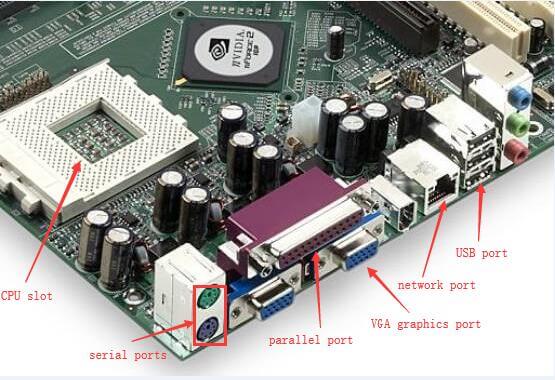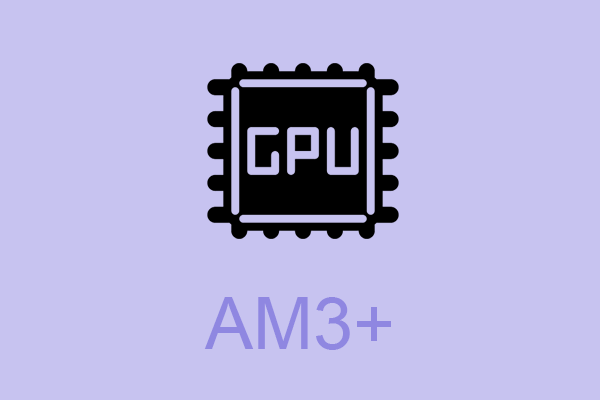This essay from MiniTool will introduce you with 20 major components of a motherboard together with their basic information including their functions.
According to Wikipedia, a motherboard is the main printed circuit board (PCB) in common computers (both desktops and laptops) as well as other expandable systems. It is also known as a mainboard, main circuit board, system board, baseboard, logic board, planar board or mobo.
Motherboard Components and Their Functions
There are many components found in a motherboard. Some of them are major motherboard components while others are not. The following is a motherboard components list.
20 Major Motherboard Components
- CPU (Central Processing Unit) chip
- RAM (Random Access Memory) slots
- Southbridge/northbridge
- BIOS (Basic Input/Output System)
- I/O port
- USB (Universal Serial Bus)
- CPU slot
- PCI (Peripheral Component Interconnect) slot
- AGP (Accelerated Graphics Port) slot
- ISA (Industry Standard Architecture) slot
- Parallel port
- FDC (Floppy-Disk Controller)
- IDE (Integrated Drive Electronics) controller
- CMOS (Complementary Metal-oxide-semiconductor) battery
- Power supply connector
- Mouse and keyboard ports
- DIP (Dual In-line Package) switch
- Jumper
- Heat sink/heatsink (cooling system)
- Clock generator
1. CPU (Central Processing Unit) chip
CPU is the electronic circuitry in a computer that executes instructions that make up a program. It is also known as a central processor or the main processor. The CPU executes the basic logic, arithmetic, controlling as well as input/output (I/O) operations specified by the instructions in the desktop programs.
2. RAM (Random Access Memory) slots
RAM is a kind of computer memory that can be read and written. It is mainly used to save data and machine code. A RAM device permits data to be read or written in nearly the same amount of time no matter where the data’s physical location is in the memory. Compared to the direct-access storage devices like hard drives, CD/DVD and magnetic tapes, RAM media is much faster for data reading and writing.
3. Southbridge/northbridge
They are the two chips in the core logic chipset on the motherboard. Typically, the southbridge implements the slower capabilities of the motherboard in a northbridge/southbridge chipset computer architecture.
The northbridge, also known as host bridge or Memory Controller Hub, is connected directly to the CPU via the front-side bus (FSB). It is responsible for tasks requiring the highest performance. Together with the southbridge, they manage communications between the CPU and other motherboard components.
4. BIOS (Basic Input/Output System)
BIOS, also called system BIOS, PC BIOS or ROM BIOS, is firmware that is used to perform hardware initialization during the booting process; and to provide runtime services for operating system and programs. The BIOS firmware is the first software to run when powered on; it is re-installed on a PC’s system board.
5. I/O port
Input/output ports are the connections between the CPU and peripheral devices on a motherboard. There are two complementary methods to perform input and output processes: memory-mapped I/O (MMIO) and port-mapped I/O (PMIO). Alternatively, you can use dedicated I/O processors, called channels on mainframe computers, which execute their own instructions.
6. USB (Universal Serial Bus)
USB is an industry standard that creates specifications for connectors, cables and protocols for connection; power supply (interfacing) and communication among computers, computer peripherals as well as other desktops. There are a great many USB hardware including several different connectors, of which USB-C is the latest kind.
7. CPU slot
A CPU slot, also called a CPU socket or Processor socket, contains one or more mechanical components that provide mechanical and electrical connections between the PCB and a microprocessor (CPU). Therefore, you can install a CPU on a motherboard without soldering.
8. PCI (Peripheral Component Interconnect) slot
Peripheral Component Interconnect is a local computer bus for connecting hardware to a computer. It supports all the functions of a processor bus. PCI is usually been called Conventional PCI to distinguish it from its successor PCI Express (PCIe, PCI-e or PCI-E).
PCI Express is a high-speed serial computer expansion bus standard designed to replace the older PCI, PCI-X and AGP bus standard. It is a general-use motherboard interface for the graphics card, SSDs, hard drives, Wi-Fi as well as Ethernet hardware connections.
9. AGP (Accelerated Graphics Port) slot
AGP was designed as a high-speed point-to-point channel for connecting a video card (graphics card) to a computer system. Primarily, it was used to assist in the acceleration of 3D computer graphics. AGP is originally designed to be a descendant of the PCI series of connections for video cards. Yet, it was replaced by the PCIe slots.
10. ISA (Industry Standard Architecture) slot
ISA is the 16-bit internal bus of IMB PC/AT and similar computers that are based on Intel 80286 and its immediate successors during the 1980s. It was backward compatible with the 8-bit bus of the 8088-based IBM PC largely.
There once was an attempt to extend ISA into a 32-bit bus, called Extended Industry Standard Architecture (EISA). The attempt wasn’t very successful and the EISA was largely replaced by the later VESA Local Bus and the PCI bus.
11. Parallel port
A parallel port is a kind of interface for attaching peripherals on desktops. The name of this kind of port is derived from the way the data is sent. That is, the parallel ports send multiple bits of data at the same time. Serial interfaces, on the contrary, send bits one data at once. To achieve parallel data transfer, there are multiple data lines in the parallel port cables. The parallel port cable is larger than the cable of a contemporary serial port, which only has one data line within.

12. FDC (Floppy-Disk Controller)
FDC is a special-purpose chip and associated disk controller circuitry. It controls and directs reading from and writing to a computer’s floppy disk drive (FDD).
13. IDE (Integrated Drive Electronics) controller
The devices used for connecting IDE, Ethernet, FireWire, USB and other systems can be called host adapter. So, the IDE controller refers to the host adapter. A host adapter, also called a host controller or a host bus adapter (HBA), connects a computer (acting as the host system) to other network and storage devices.
14. CMOS (Complementary Metal-oxide-semiconductor) battery
CMOS battery, also called memory battery, clock battery or real-time clock (RTC), is generally a CR2032 lithium coin cell. The lifespan of the CMOS battery is estimated to be three years when the power supply unit (PSU) is unplugged or switch off.
15. Power supply connector
A power supply provides the necessary electrical power to let the computer to work. It takes standard 110-Volt AC (Alternative Current) power to DC (Direct Current) power of 12 Volt, 5 Volt, 3.3 Volt, etc.
16. Mouse and keyboard ports
All computers have a keyboard port connected directly to the motherboard. There are two types of connectors. The oldest one is a special DIN (Deutsches Institut für Normung) connector while the newest one is the mini DIN PS/2-style connector. Many PCs use the PS/2-style connectors for both keyboard and mouse; and the connectors are marked clearly for different usage.
17. DIP (Dual In-line Package) switch
A DIP switch is a manual electric switch packaged with others in a standard dual in-line package. The term may refer to an individual switch or the whole unit. The DIP switch is designed to be used on a printed circuit board (motherboard) together with other electronic motherboard components. It is usually used to customize the behavior of an electronic device for specific situations.
18. Jumper
A jumper is a short length of conductor that is used to close, open or bypass part of an electronic circuit. Typically, jumpers are used to set up or configure printed circuit boards like the motherboard.
19. Heat sink/heatsink (cooling system)
A heat sink is a passive heat exchanger that transfers the heat generated by parts of motherboard into a fluid medium like liquid or air. The fluid medium will dissipate away from the device. Thus, the temperature of the device is kept within a tolerable range. On the motherboard, the heatsink is usually used to cool CPU, GPU (graphics processing unit), chipsets and RAM modules.
20. Clock generator
A clock generator is an electronic oscillator (circuit) that produces a clock signal for usage in synchronizing a circuit’s operation. The clock signal ranges between high and low frequencies, thus creating a metronome for the coordination of actions.
What Are the Two Main Components on the Motherboard?
After reading the above contents, you can figure out that the two main components on the motherboard are CPU and RAM. They also list in the first two locations in the above. Actually, the above motherboard components are listed mainly based on their importance on the motherboard. Yet, that is just our personal opinion. Those components’ importance is different in different situations.


![[Step by Step] How to Update CPU Drivers Windows 10/11?](https://images.minitool.com/partitionwizard.com/images/uploads/2020/07/how-to-update-cpu-drivers-thumbnail.png)
![[Solved] Is SSD Good for Long Term Storage: Past VS Now](https://images.minitool.com/partitionwizard.com/images/uploads/2020/07/is-ssd-good-for-long-term-storage-thumbnail.jpg)

User Comments :